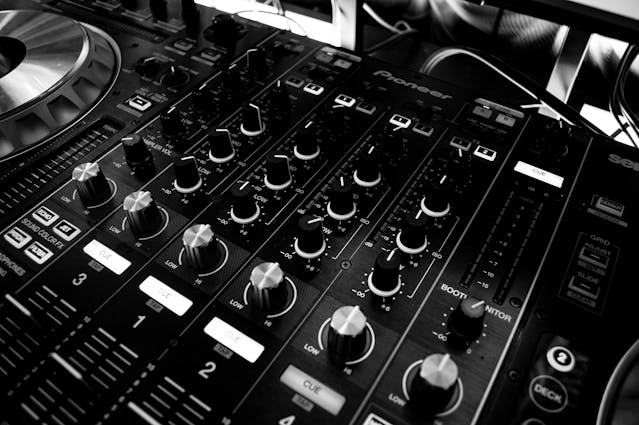Music Production: How Technology Is Changing the Way We Create Music
Music production has undergone a radical transformation in recent years, thanks to advancements in technology. With the rise of digital tools, software, and innovative hardware, producing music has become more accessible, efficient, and creative. Today, artists and producers are using a variety of digital platforms to compose, arrange, mix, and master their music, all from the comfort of their own studios or even their bedrooms.
In this article, we will explore how technology has revolutionized music production, the tools that are reshaping the industry, and the way artists approach the creative process.

The Digital Revolution in Music Production
Before the digital era, producing music required expensive studio equipment, specialized knowledge, and access to professional sound engineers. Traditional recording studios were often the only place where artists could create high-quality music, and the process was labor-intensive and time-consuming.
The advent of digital audio workstations (DAWs) and affordable recording equipment has drastically lowered the barrier to entry. Today, artists can produce entire albums on their laptops using software that was once only available to professionals. The ability to record, edit, and mix music digitally has allowed more people to enter the world of music production.
Digital Audio Workstations (DAWs)
At the heart of modern music production is the Digital Audio Workstation (DAW). A DAW is software used to record, edit, mix, and produce audio. It serves as the central hub for all music production tasks, offering a wide range of tools that allow artists to compose music, manipulate sounds, and finalize tracks.
Popular DAWs include:
- Ableton Live: Known for its flexibility and intuitive interface, it is popular among electronic music producers.
- FL Studio: Famous for its user-friendly layout and strong beat-making capabilities, FL Studio is often the choice for beginner and intermediate producers.
- Logic Pro X: Favored by professional producers and musicians, Logic Pro X is known for its powerful features and extensive library of sounds and plugins.
- Pro Tools: A favorite in professional studios, Pro Tools is often used for high-end mixing and recording sessions.
DAWs allow for the recording and manipulation of audio files (such as vocals, instruments, or digital sound effects), and they come with a variety of built-in features like MIDI sequencing, multi-track recording, virtual instruments, and sound libraries.
The Rise of Virtual Instruments and Plugins
In the past, musicians had to rely on physical instruments and equipment, but now many of these can be replicated through virtual instruments and plugins. These software-based tools simulate the sound of traditional instruments and can be used to create a wide variety of musical styles.
- Virtual Instruments (VSTs): Virtual instruments are software programs that emulate real-world instruments like pianos, guitars, drums, strings, and synthesizers. They offer immense flexibility, allowing producers to play and record instruments that they may not have access to physically.
- Plugins: Plugins are software add-ons that enhance a DAW’s capabilities. These can range from audio effects (reverb, delay, EQ) to virtual instruments, sound libraries, and mastering tools. Popular plugin developers like Waves, Native Instruments, and Soundtoys provide a variety of professional-grade tools that enhance the creative process.
These tools allow producers to experiment with new sounds and layers in their music, creating intricate compositions and pushing creative boundaries in ways that would have been difficult or expensive with traditional methods.
Home Studios and Affordable Equipment
With the availability of compact and affordable music production equipment, it's now possible to create professional-quality music from home. Home studios have become increasingly popular, especially in the age of remote work and independent artists. Key equipment needed for a home studio includes:
- Audio Interface: This device converts analog sound into digital form for processing in a DAW. Popular options include Focusrite Scarlett and PreSonus AudioBox.
- Microphones: High-quality microphones are essential for recording vocals and acoustic instruments. USB microphones are great for beginners, while XLR microphones offer more professional-grade options.
- MIDI Controllers: These devices allow producers to create and edit music with virtual instruments using a keyboard, pads, or knobs. MIDI controllers from brands like Akai, Novation, and Arturia are widely used by producers of all levels.
- Headphones & Studio Monitors: To mix and master music with precision, high-quality headphones and studio monitors (speakers designed for accurate sound reproduction) are essential. Brands like Audio-Technica, Beyerdynamic, and KRK are popular choices.
The combination of these tools has made it possible for anyone with a passion for music to set up a professional-sounding studio without a large budget. Artists no longer have to book expensive studio time; instead, they can work from the comfort of their own homes.
Music Collaboration in the Cloud
Collaboration has always been a key part of the music industry, and technology is making it easier than ever to work with artists from all over the world. Cloud-based tools and platforms have opened up new avenues for collaboration, even when team members are located in different parts of the globe.
Examples of Cloud Collaboration Tools:
- Splice: A platform that allows artists to collaborate, share projects, and access millions of samples, loops, and sounds.
- Google Drive/Dropbox: These platforms make it easy to share large audio files and project files between collaborators.
- Auddly: A cloud-based platform designed to help songwriters and artists collaborate, track royalties, and manage their music projects.
With cloud services, musicians can collaborate in real-time, share audio files, make changes remotely, and bring together artists with different backgrounds and skills. This connectivity has been a game-changer, especially during the COVID-19 pandemic, which saw many musicians transition to virtual collaborations.
AI and Machine Learning in Music Production
Artificial intelligence (AI) and machine learning are beginning to play a significant role in music production. AI-powered tools can assist in everything from generating music to automating tedious tasks in the production process.
- AI for Composition: AI tools like Aiva and Amper Music can generate original compositions based on user input, allowing for instant music creation.
- AI in Mixing and Mastering: AI-powered software like LANDR can analyze your track and automatically master it, applying necessary EQ and compression to ensure it sounds polished.
- Music Recommendation Algorithms: Streaming services like Spotify and Apple Music use AI to curate personalized playlists and suggest new music based on users' listening habits.
AI and machine learning tools are making music production faster, more accessible, and more customizable, empowering artists to produce tracks without needing extensive technical expertise.

The Future of Music Production: Virtual Reality (VR) and Augmented Reality (AR)
Looking ahead, the integration of Virtual Reality (VR) and Augmented Reality (AR) into music production could bring about groundbreaking changes in how we interact with sound.
- Virtual Reality Studios: VR platforms like TheWaveVR allow artists and producers to create, perform, and experience music in an entirely immersive virtual environment. In the future, VR may allow musicians to visualize sound, perform in virtual spaces, or collaborate in real-time with others in a fully immersive world.
- Augmented Reality for Music Creation: AR can enable new ways of composing and producing music by overlaying virtual instruments or audio effects on the physical world. Imagine controlling sound by interacting with virtual objects or seeing your instruments come to life through AR glasses.
While these technologies are still emerging, they hold tremendous potential to change the landscape of music production even further.
Conclusion: A New Era for Music Producers
Technology has democratized music production in ways that were unimaginable just a few decades ago. With powerful software, affordable hardware, and cloud-based collaboration tools, producing high-quality music has never been easier or more accessible. As technology continues to advance, artists will have even more opportunities to explore new creative possibilities and push the boundaries of what is possible in music.
From digital audio workstations and virtual instruments to AI-powered tools and VR collaboration spaces, the future of music production is bright, diverse, and incredibly exciting for creators worldwide. Whether you're a bedroom producer or a seasoned professional, technology has leveled the playing field and opened doors to limitless creative expression.












